Jean Nicolet (1598-1642)
Jean Nicolet (or Nicollet), my 10th great-grandfather on the Vadnais side, was born to Thomas and Marguerite (Delamer) Nicolet about 1598 in Cherbourg, a port city in the department of Manche, Normandy, northwestern France.1
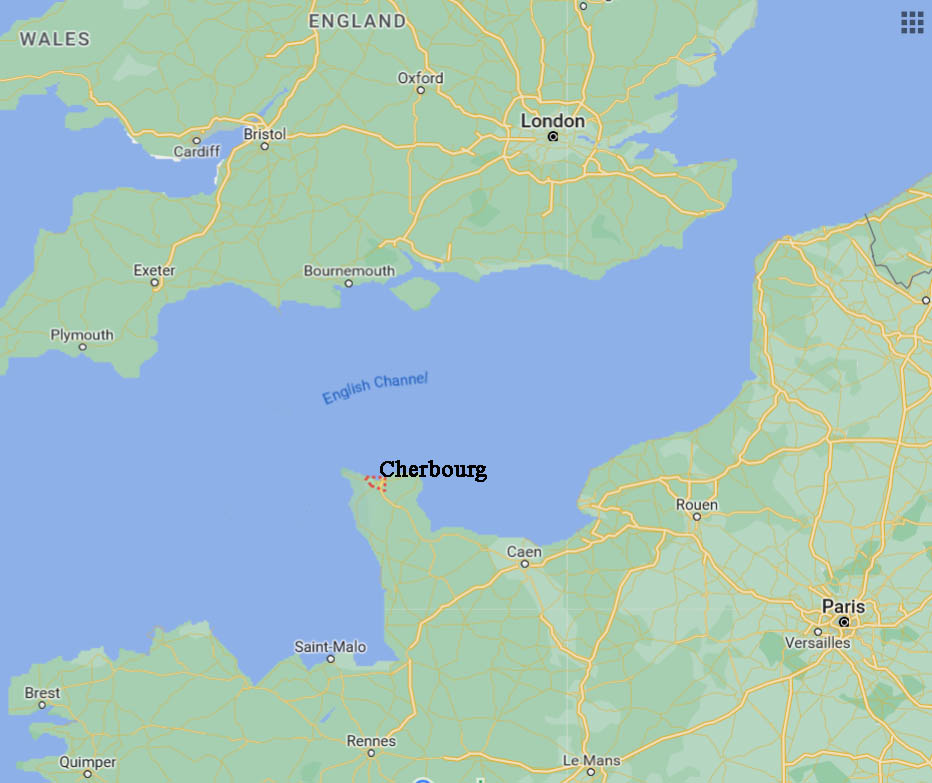
Cherbourg was one of the first ports the Titantic visited on its fateful journey.
In 1618, at about age 19, Nicolet was one of 28 men who sailed to New France as a clerk of the Company of Merchants. That same year, Samuel de Champlain instructed that Nicolet go and spend the winter with the Algonkin on Allumette Island, a strategic fur-trade spot on the Ottawa River. During the 2 years that Jean stayed on Allumette Island he learned the Huron and Algonquin languages and customs, and explored the surrounding area.
It was in early 1620 that he returned to Quebec, made his report and was subsequently given another assignment: to make contact with the Nipissings on the shores of the lake with the same name in Northeastern Ontario. His mission was to consolidate their alliance with the French in order to ensure that their furs did not find their way to the English at Hudson Bay. Nicolet spent 9 years living among the Nipissing. He had his own dwelling and a store where he would trade with members of the various tribes. The native population called him Manitouiriniou (man of wonders). In about 1623 he married Jeanne Giisis-Bahmahmaadjimiwin, a Nipissing native, in the custom of the Pays d’en Haut (a territory of New France), which was not considered valid by the Roman Catholic Church. However, his marriage to Jeanne probably allowed him to better manage transactions and relationships with the Indian tribes. The French referred to Nicolet’s wife as Jeanne Nipissing.
Jeanne gave birth to their only child, Euphrasie Madeleine (or Euphrosine Marguerite) sometime between 1627 and 1628.
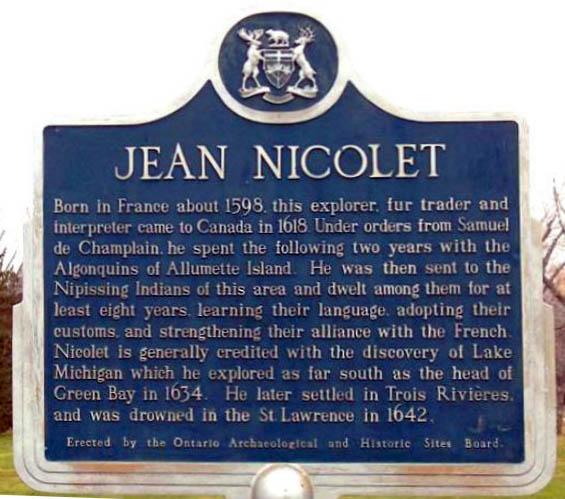
It was in July 1629 that Nicolet returned to Quebec with his daughter; her mother Jeanne was most likely deceased. Shortly after their return Quebec fell into the hands of the Kirke brothers who took control for England. Almost all of the French were repatriated to France, but Nicolet, along with his daughter, joined the Algonquin in the land of the Hurons where he negotiated with the Hurons to not trade with the English. Quebec would not be returned to the French until 1633 when the Treaty of Saint Germain was signed.
After the French returned to New France, Nicolet, on June 20, 1633, asked and received permission to set himself up at Trois-Rivieres as a clerk of the Company of One Hundred Associates (They held a monopoly on the fur trade in New France.) However, before he began his new duties, Samuel de Champlain requested that Nicolet embark on a purely diplomatic trip, something he had successfully done before. Good relations with the native populations was vital to the growth of the fur trade and it had been said that there existed a people called the Ho-Chunk (Winnebago) who were at war with Lake Huron tribes; the hope was that Nicolet could smooth the relations between the tribes.
Nicolet left Quebec on July 1, 1634 bound for Trois-Rivieres. From there he followed the Ottawa River, branched off at Allumette Island in the direction of Lake Nipissing (all quite familiar to Nicolet) and then traveled down the French River to Lake Huron. On his way he recruited an escort of 7 Hurons. From Lake Huron he went to Michilimackinac (Mackinac Island) and onward to Lake Michigan via Sault-Sainte-Marie which took him into Lake Superior where he first met the Winnebago. Although it is thought that he then went to the Red Banks on Lake Michigan (modern day Green Bay), current research believes that he actually landed near Marinette and walked to a native Menominee Village where, within a week or two, thousands of people gathered to see the Europeans. Marinette is about 50 miles north of Green Bay along the shoreline. Whether Green Bay or Marinette, in all likelihood, Nicolet was the first European to set foot in what is now Wisconsin.
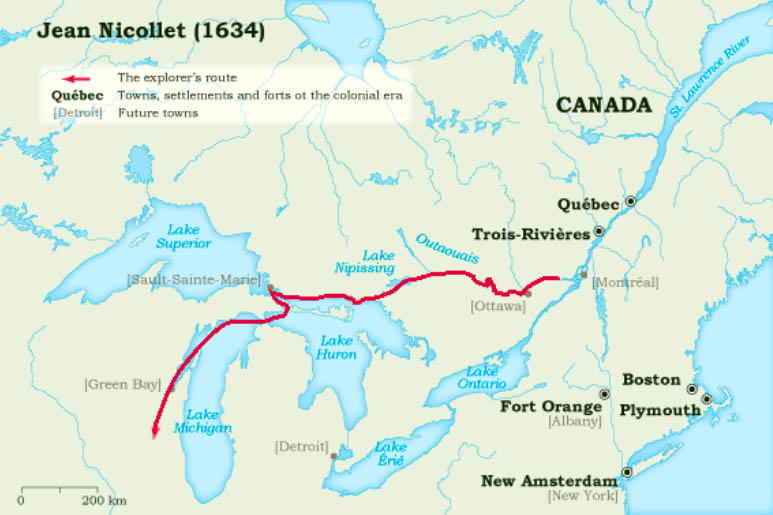
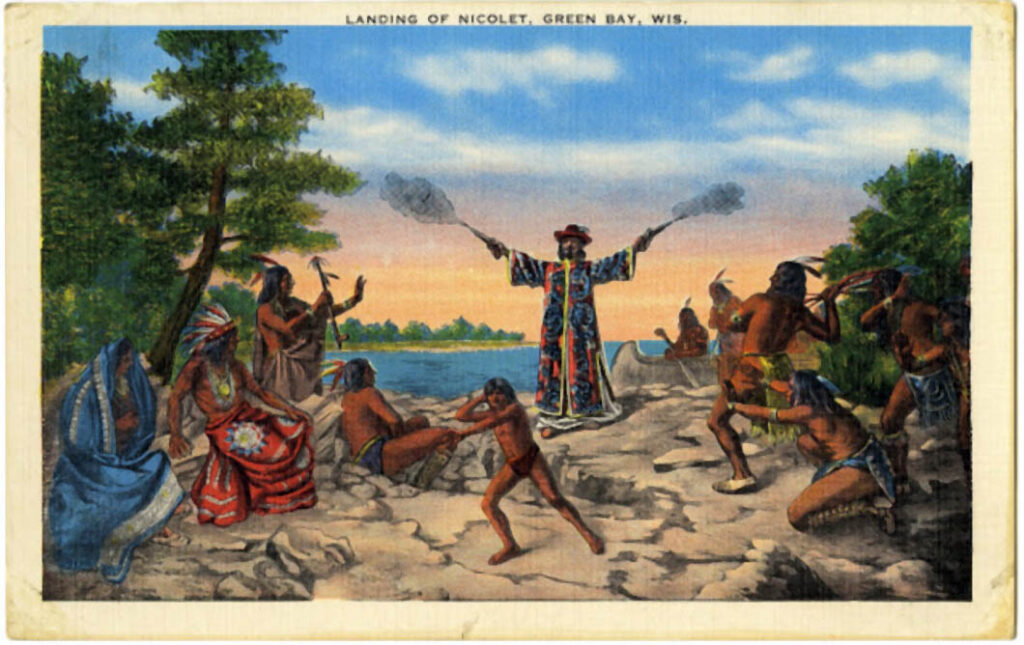
This is quite exaggerated. Nicolet did not land with guns blazing, and the elaborate robe he is shown wearing was more than likely a silk cape, the formal attire of a French gentleman of his time. Additionally, it is thought that he landed near Marinette, not Green Bay. (The most prevalent story of Nicolet’s landing in 1634 is generally wrong. You know that if something is repeated often enough, people think it must be true.) There is even a U. S. postage stamp with this same illustration.
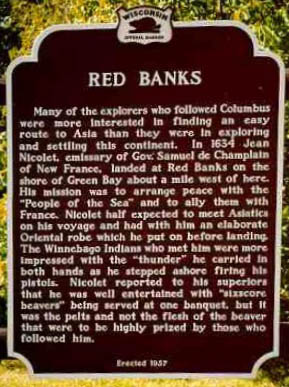
Known as the peacemaker, Nicolet became the ambassador to the Ho-Chunk (Winnebago) people. Over the year or so that he lived among the tribe he held counsel, and peace was established between the Winnebago and the tribes to the north along Lake Huron, if only for a few years. Nicolet’s skill as a peacemaker opened up opportunities for trade and commerce.

With the help of Ho-Chunk guides, Nicolet explored down the Fox River to within 3 days travel from the Wisconsin River. For whatever reason, he decided to return to Quebec, not knowing that he had almost reached the upper Mississippi River. Samuel de Champlain died a few months after his return, which put a halt on further explorations of the newly discovered land.
Upon his return to Trois-Rivieres in 1635, Nicolet assumed the position he had previously requested, clerk of the Company of One Hundred Associates. In addition, he was also their Algonquin interpreter. He held the position until 1637 and again in 1639.
In May 1637 Nicolet was granted, in common with his future brother-in-law Olivier LeTardif de Honnefleur, 160 arpents (about 135 acres) of wooded land on the outskirts of Trois-Rivieres. About the same time, in co-ownership with Olivier, he obtained the Belleborne fief, which was probably on the Plains of Abraham, at Quebec. This is when Nicolet added his “dit” name and became Jean Nicolet de Belleborne.
Nicolet married a second time (the church sees it as the first time) at about 39 years old. His future wife was 11 year old Marguerite Couillard, daughter of Guillaume Couillard de l’Espinay and his wife, Guillemette Hebert (they are my 11th great-grandparents via one of their other daughters). The marriage took place on October 7, 1637 in Notre-Dame-de-Quebec with the marriage contract signed October 22, 1637 in front of notary Jean Guitet. The couple did not live together until she was no longer considered a child at age 13. Of the 2 children they had, Ignace died as an infant and Marie Marguerite lived into adulthood and married.
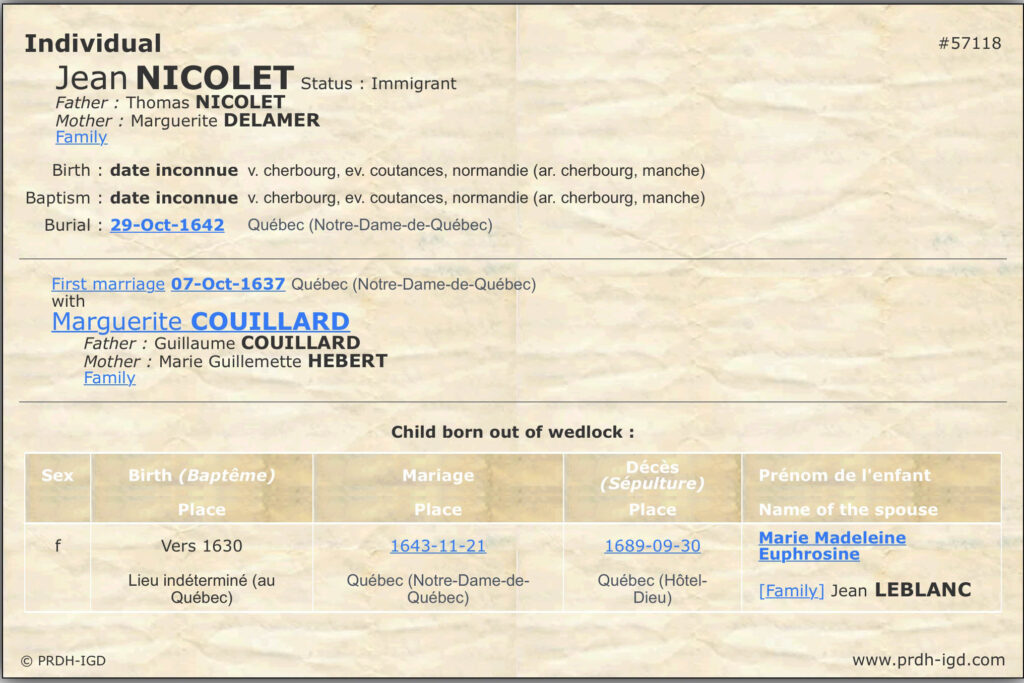
Nicolet was considered a leading figure in Trois-Rivieres. His knowledge of Indian languages and customs earned him the respect of everyone. It is said that “his greatest joy, in the spare moments that his duties allowed him, was to act as an interpreter for the missionaries and to teach religion to the Indians.”
On October 27, 1642, late in the afternoon, Nicolet was summoned by a messenger of the governor requesting his immediate assistance. Nicolet was temporarily away from home in Quebec City where he was replacing his brother-in-law Olivier LeTardif as the head clerk of the company. The governor wanted Nicolet to go as quickly as possible to Trois-Rivieres to save an Iroquois (Mohawk) prisoner that the Hurons (Algonquins) were going to torture and kill. If the Iroquois prisoner was killed, the lives of all of the residents in the area were threatened because the Iroquois would take revenge on the general population. Nicolet was probably the only person who could reason with the Hurons and save the native and all of the other potential victims.
Francois de Chavigny had plans to go to Trois-Rivieres the following morning, but Nicolet convinced him to leave that very evening. They were joined by Jean Ferre and Noel Girardeau. In transit the group met with a violent storm and despite their efforts, the shallop that was taking them to Trois-Rivieres, via the Saint Lawrence River, was overturned by a strong gust of wind south of Quebec City, near Sillery. Francois de Chavigny, who knew how to swim, was fortunate to be saved by the Jesuits and sadly the other 3, which included Nicolet, drowned; none of them knew how to swim. The bodies were not recovered. Nicolet was only 44 years old.
A memorial service was held for the 3 men on October 29, 1642. Almost all of the population of New France, around 200 people, was in attendance. Nicolet’s widow, Maguerite Couillard, was only 16 years old at the time of his death. She had their young daughter Marie Marguerite to bring up and she had helped raise Nicolet’s daughter Euphrasie Madeleine. Guardianship of Marie Marguerite was given to Olivier LeTardif, and Euphrasie Madeleine Nicolet married Jean LeBlanc the following year (my 9th great-grandparents).

The following translation is only of the middle part of the document.
Translation:
S. 22 (the 22nd burial (in this case funeral service) at Notre-Dame-de-Quebec in 1642)
M. Nicolet (Monsieur Nicolet)
On the 29th, there was the funeral of Mister Nicolet and three men of Mister de Chavigny, drowned in a boat which was sailing from Quebec to Sillery. The bodies were not found. The names of the three men are Jehan Ferre, Noel Girardeau and
End of translation.
In February of 1643 Marguerite Couillard purchased Jean Nicolet’s property. A few years later, on November 12, 1646, she remarried to Nicolas Macard dit Champagne.
Thanks for visiting, come back soon,
Cynthia
© 2023 Copyright by Cynthia Vadnais, All Rights Reserved
Jean Nicolet (1598-1642) Read More »
